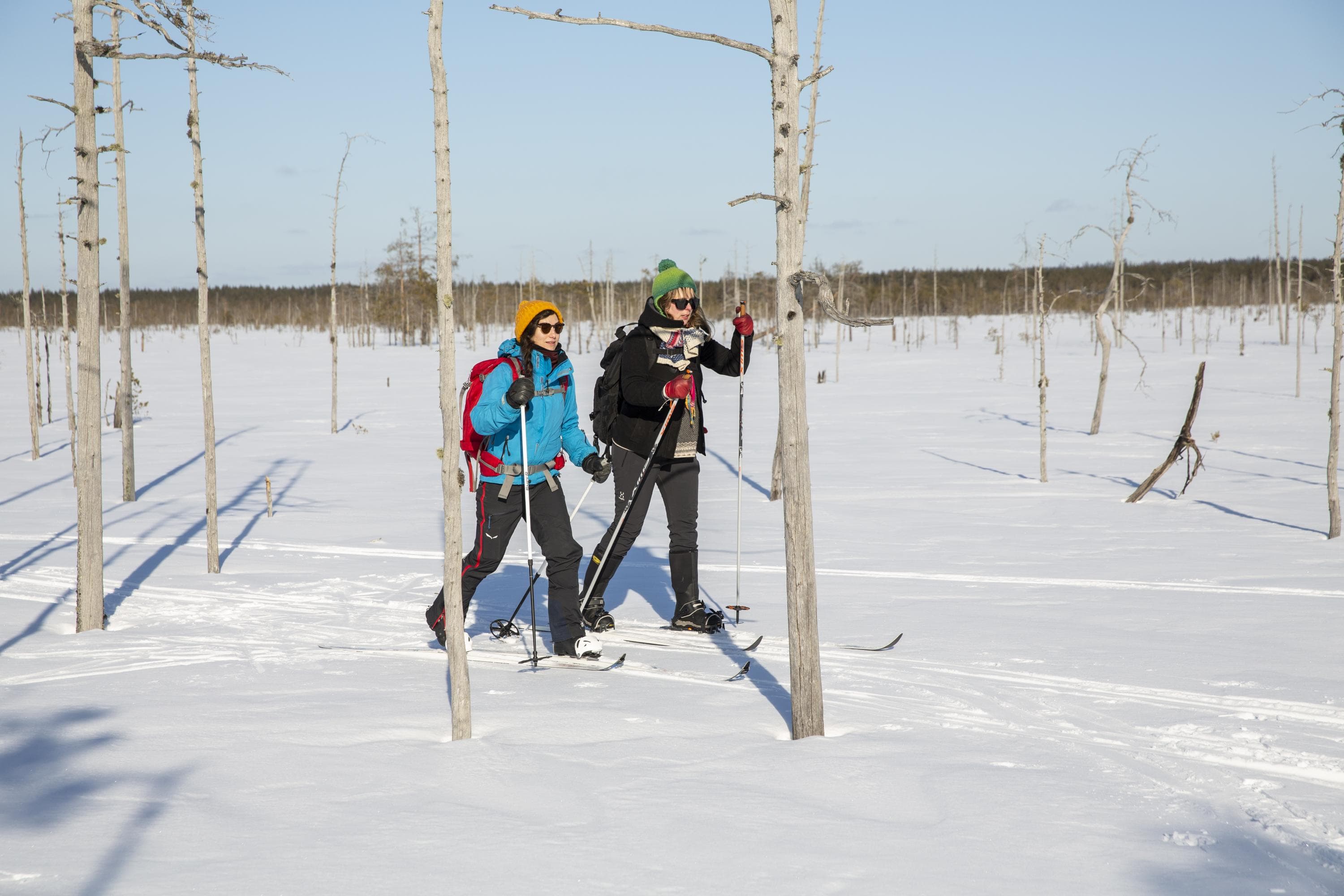Text:
Juho Niemelä is an experienced outdoorsman who has previously worked as a customer service officer for Metsähallitus, Parks & Wildlife Finland.
On the eve of New Year’s Eve, the sky is pitch black as we cross national road 4 and make our first ski tracks in the snow at the gateway of the Hammastunturi wilderness. The tracks are deep, with the soft powdery snow reaching well above our knees. The pulka keeps falling over onto its side in the fluffy snow.
Our forward progress ends after just a half a kilometre. A day on the bus and the dark forest take their toll - we decide to pitch our tent. However, we have never camped in over half a metre of snow. We decide to dig a hole for the tent, which turns out to be an almost impossible task with sugary snow.
Eventually, we do get the tent up, but we won’t be winning any points for style. The frenzied clearing of snow has left our shovel, which was far too flimsy, in tatters, so we will have to return to Saariselkä in the morning to buy a new one.
At the same time, we decide to change our destination to Urho Kekkonen National Park, where we will head with a new shovel. There, our journey comes to its bitter end, with the pulka taking a dunk in the Rautuoja River. Fortunately, the Rautulampi Day-use Hut is right nearby, and we can dry our gear and thoroughly soaked self-esteem there, followed by a return to Saariselkä with our tails between our legs.
The above description might be an example of how you should not start hiking in the winter.
This article provides tips for day and night hikes in the winter.
It also describes the order in which you should start winter hiking. You should never rush headlong into the wilderness in the depths of the polar night, but instead practise your basic winter hiking skills, such as crossing snowy terrain and dealing with the cold, on day trips.
When you start getting the hang of these things, you can then think about doing overnight and weekend trips. At first, you should rely on the lean-to shelters or open wilderness huts of the local national park. Even if your goal is to sleep in a tent, you should do so near a service structure or even in your own yard. This will provide a sense of security if you run into any snags during the night.
On a day trip, you will learn the basics of moving through winter nature
When planning your first winter hike, two factors in particular will affect its success: a suitable destination and the prevailing conditions.
Early spring is a much more pleasant time than the polar night for getting to know winter nature, as the sun will gradually start feeling warm on your cheeks and you’ll have plenty of light in the evening. You should also keep an eye on weather forecasts for your hiking destination. If extremely frigid temperatures or severe snowstorms are expected, you should definitely consider rescheduling your trip. Also remember to watch for wind conditions, as the wind significantly increases the bite of the cold.
You should also take advantage of a familiar summer hiking destination on your first winter hike. Dealing with new conditions is easier if you are already familiar with the environment.
If you do not have a familiar hiking destination, you should check out the maps on the Luontoon.fi website to see what destinations are close to you. It is a good idea to check the destination information to see whether it is maintained during the winter, the parking area is ploughed or it can be reached by public transportation. You should choose a sufficiently short route with a good campsite as your first destination. As you gain experience, you can extend the length of your hikes.
Even if there is no winter maintenance, a trail will usually form on the most popular hiking trails. By renting snowshoes or skis suitable for backcountry use, you can break free from the trail and enjoy the freedom of a pristine winter landscape. If you have cross-country skis at home, you can also make use of the ski track network when hiking in the winter.
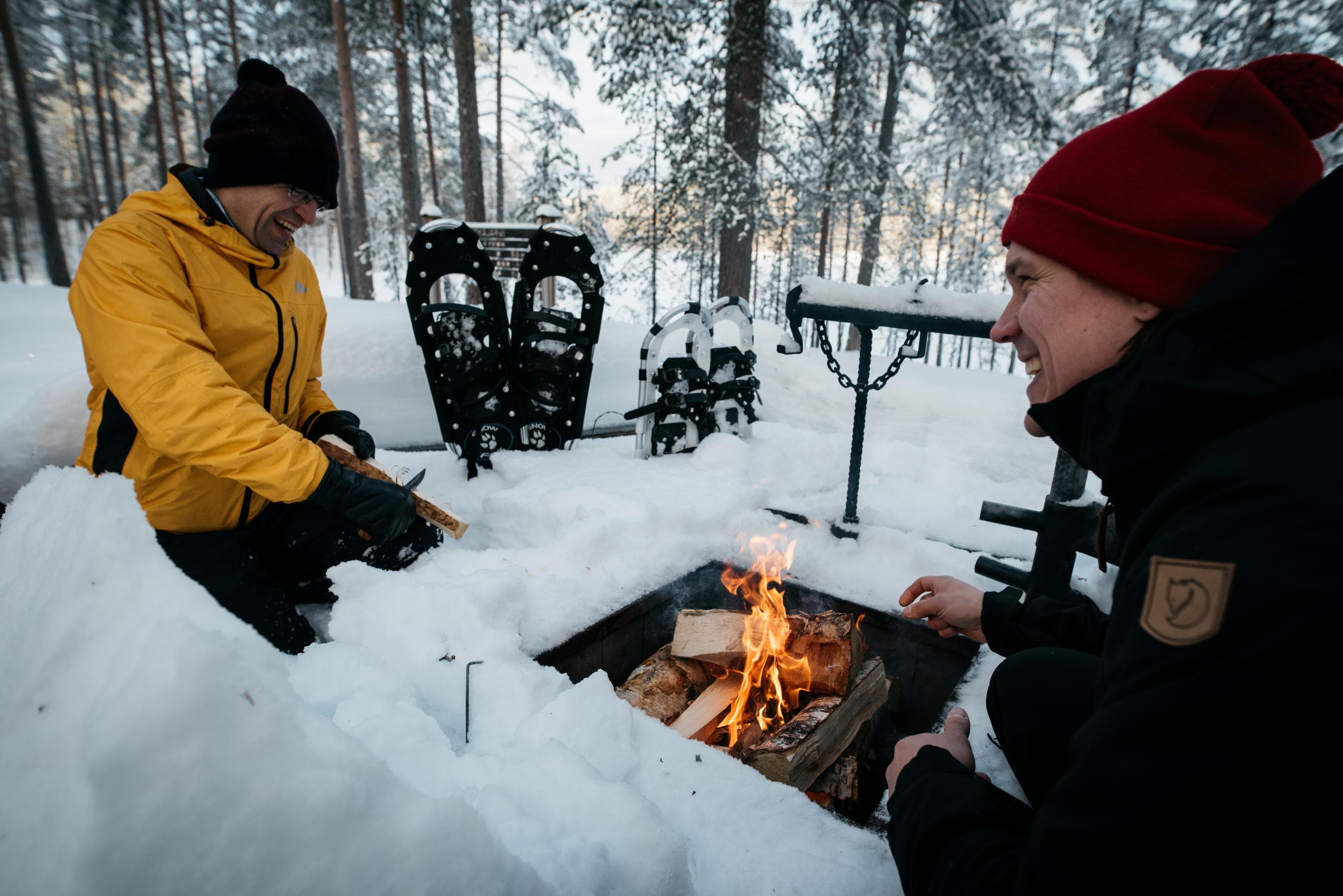
No special gear is needed for day trips in the winter
Regular gear found at home will usually do for a winter hike, provided that you have sufficiently warm footwear, hats and gloves tucked away in your closet. Cold fingers or toes are the surest way to guarantee suffering on your winter hike.
Footwear with removable liners are ideal for winter hiking, but full-height hiking boots without liners will also do as long as there is room for an extra pair of wool socks, should they be necessary. Especially in Southern Finland, winter conditions can often be very slippery, so studded footwear or slip-on snow spikes/crampons are an excellent option.
Even though mittens offer the best warmth, with gloves you do not necessarily have to take them off to manipulate things. Gloves get wet easily in the winter, so it is a good idea to have a few pairs along on your day trip. It is also a good idea to bring a spare hat, as hats practically always get sweaty when you are active. Pulling on a dry hat while taking a break is pure luxury on a winter hike. A good winter hat provides adequate protection for your ears and neck.
You should not overdress - layering is far more effective. If you feel a bit chilly while standing still, your clothing will generally be just right for when you are on the move. The more intense the physical activity, the less clothing you will usually need.
Layering and a backpack are the best friends of a winter hiker, as the backpack enables you to pack a change of clothes and make adjustments as needed.
Depending on the circumstances, it is a good idea to wear merino wool or technical underwear and a wind-resistant shell. When temperatures are very low, it is a good idea to wear microfleece garments. Remember to actively make adjustments to your clothing and ensure ventilation. The most important rule of thumb for physical activity in winter conditions is to avoid sweating.
You should always pack a warm insulated jacket or sweater for breaks. Worn on top of your regular hiking gear, clothes intended for breaks prevent the most loss of heat.
If you bring children along on the hike, it is a good idea to pack spare hats, gloves and socks, as children often get wet when they are playing in the snow. Children doing their own hiking on a trip should not be overdressed, as they are often more active than adults. However, when carrying a child in a carrier or on a pulka, they must be dressed sufficiently for them to keep warm.
A first-aid kit and map are also important on day trips. For a more detailed list of gear, see Hiking tips.
The highlight of every hike is a good and proper break
On a winter hike, your body uses up a lot of energy just to stay warm, so you should definitely put an emphasis on packing a lunch. The easiest way to do this is to make a soup at home and pack it along in an insulated food jar. Then, when you take a break, you can tuck into your lunch right away. On the other hand, food cooked over a campfire is always an experience. However, if you plan to cook in the field, you should prepare as much as possible at home.
Also remember to drink. In winter, drinking cold beverages may feel unpleasant, so it is a good idea to take along hot juice or cocoa in a thermos.
Spending time at a rest area is more pleasant if you have a soft foam seat pad to protect your bottom from the cold and wet. If you don’t have a seat pad, you can use a bundle of newspapers for the same purpose.
Remember to pack matches and a knife if you intend to make a campfire on your break. In winter, matches get wet easily, so make sure they are packed in a watertight container. Firewood may also be damp, so it is a good idea to bring fire starters, pieces of egg cartons or stearin from candles to make it easier to light a fire. Also remember to chop the firewood into sufficiently small pieces to start with and push any snow accumulated on the fireplace to the side, for example, using a piece of firewood.
For children, a break is easily the most boring part of a hike, so it is a good idea to find something for them to do. You can bring along, for example, a shovel for them to play with in the snow. This also helps them stay warm.
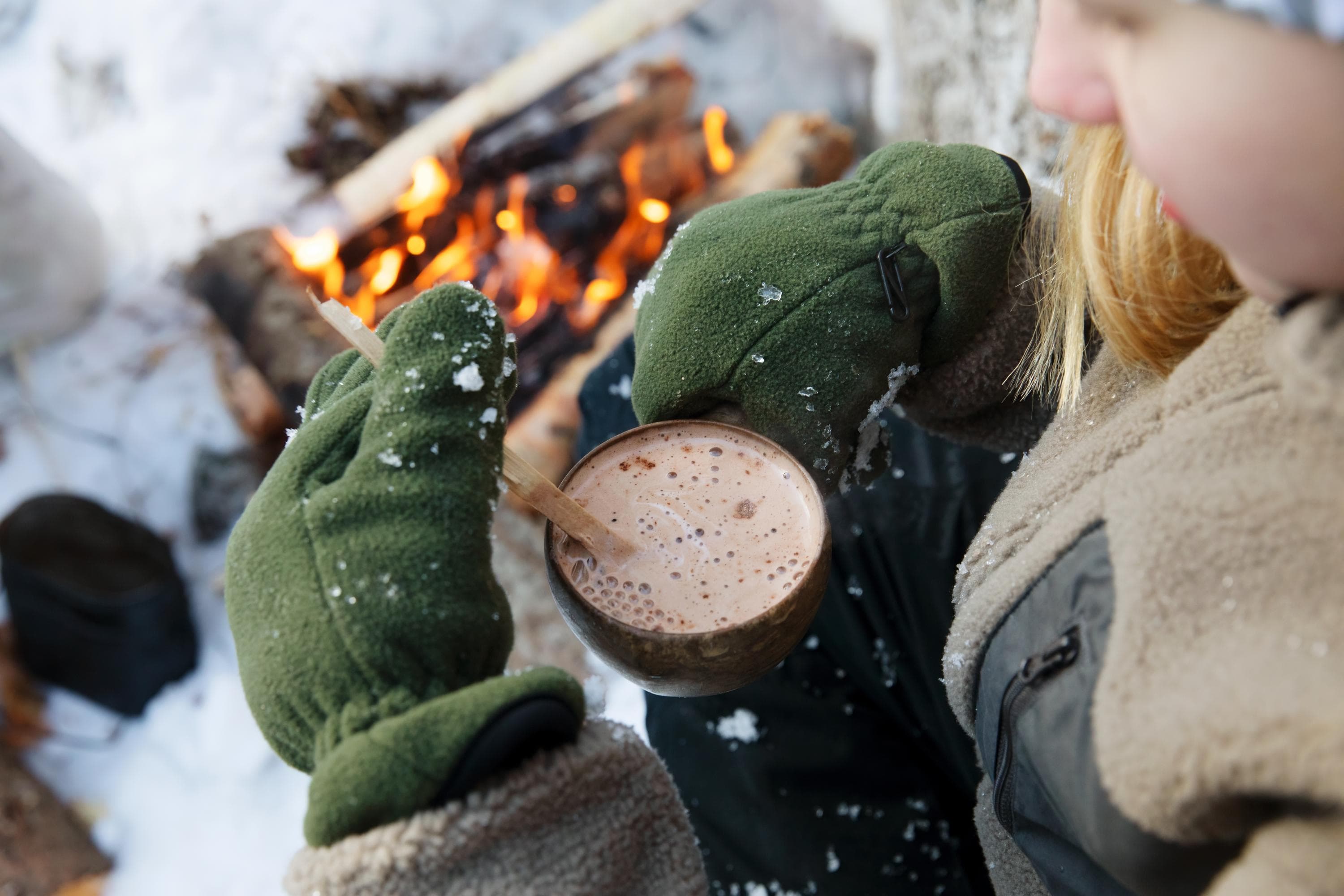
Small flatbreads can be used to make an easy and delicious winter hike treat. Put tomato purée and other desired toppings on the flatbread. Wrap the flatbreads in lightly oiled aluminium foil or cook over the fire in a covered campfire pan.
Overnight winter hike
When you move from a winter day trip to an overnight winter hike, things get a bit more demanding.
The distance travelled on an overnight hike and the time spent in nature increase. Therefore, an overnight winter hike requires more preparedness than a day trip. Overnight winter hikes also often involve a variety of winter hiking gear, such as skis and a pulka, even though you can also manage well on foot with a backpack, at least in winters with little snow in Southern Finland.
Overnight hikers must also know how to properly use gear for camping overnight, i.e. a sleeping bag, sleeping pad and a 4-season tent. Food prepared at home or drinks taken with you might not necessarily be enough to last the hike. Instead, you must know how to use a camp stove and manage your food and water supply in winter conditions.
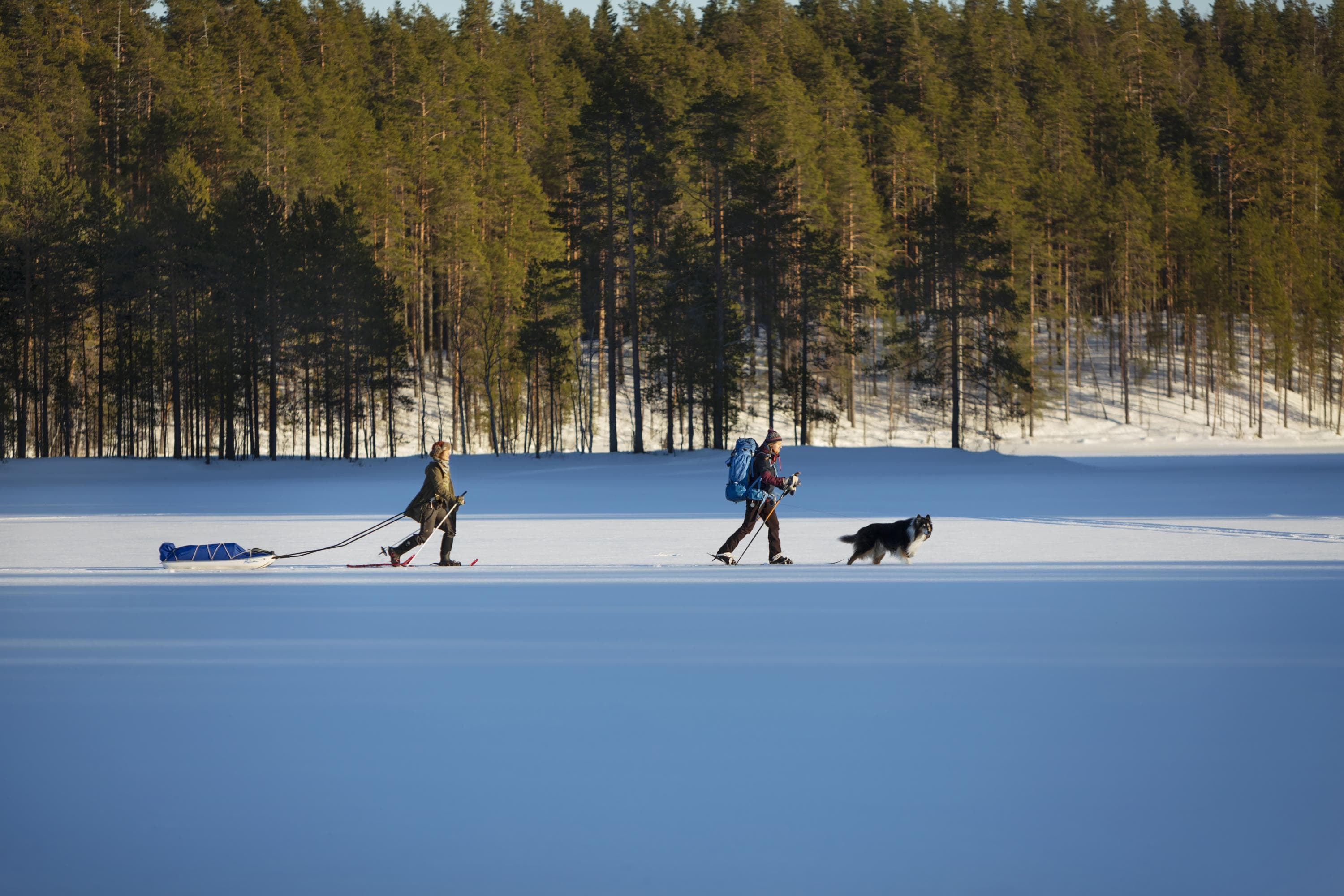
On a winter trip, safety always comes first
Winter hiking is more demanding than summer hiking, as even a fairly minor mistake can have serious consequences in cold weather.
So, make sure that you always have the right gear to ensure a safe overnight stay in the field. Also, never hesitate to turn back if you have any doubts about the conditions. If you get lost or run into, for example, a snowstorm, it is better to try to camp than start running around in a panic.
Always carry a fully charged phone and keep it in, for example, a watertight pouch with a neck lanyard. When you keep your phone close to your body, it will stay warm and the battery will hold its charge better.
Also always bring an adequate first-aid kit that you also know how to use.
A marked winter trail and a ready-made campsite are a good way to start night hiking in the winter
When heading out on a longer winter hike, a few things should be taken into account when moving about in nature.
If you are still not comfortable with finding your way in the winter, you should choose a trail that is also marked during the winter months. In the winter, markings painted on trees may be covered with frost and snow, and it may not be possible to follow the trail. Not all summer trails can be hiked at all during the winter, and it is not practical to ski on many of them due to contours in the terrain.
Some national parks have special winter trails that can be used. They are usually marked with plow markers and can be used for hiking, snowshoeing, skiing and fat biking. However, it is not a good idea to do an overnight trip on a fat bike or hiking, at least as not covering long distances. This is because not all winter trails are maintained every day and a snowstorm in the night can make the return journey a real challenge. Skis and snowshoes are the safest tool for winter hikers to have along.
More time should be reserved for moving about in the winter, as many things take longer in cold weather. The landscape also looks different, and it may be more difficult to distinguish between, for example, a lake or pond. Even if the trail is marked on a winter hike, it is important to stick to the trail and follow the map.
Know your gear
If the gear needed for winter hiking, such as skis, snowshoes and pulkas, is new, you should thoroughly familiarise yourself with it before setting out. As gear for for different kinds of winter hikes differs slightly, you should first rent and then start considering buying your own gear. If you only do winter hikes occasionally, you should not buy your own gear.
On a longer winter hike, you will often need to bring along so much gear that a pulka is the only sensible way to transport it. However, on hikes only a couple of nights long, you can still do quite well with just a backpack. In the thickly forested terrain of Southern Finland, a backpack is always a good choice.
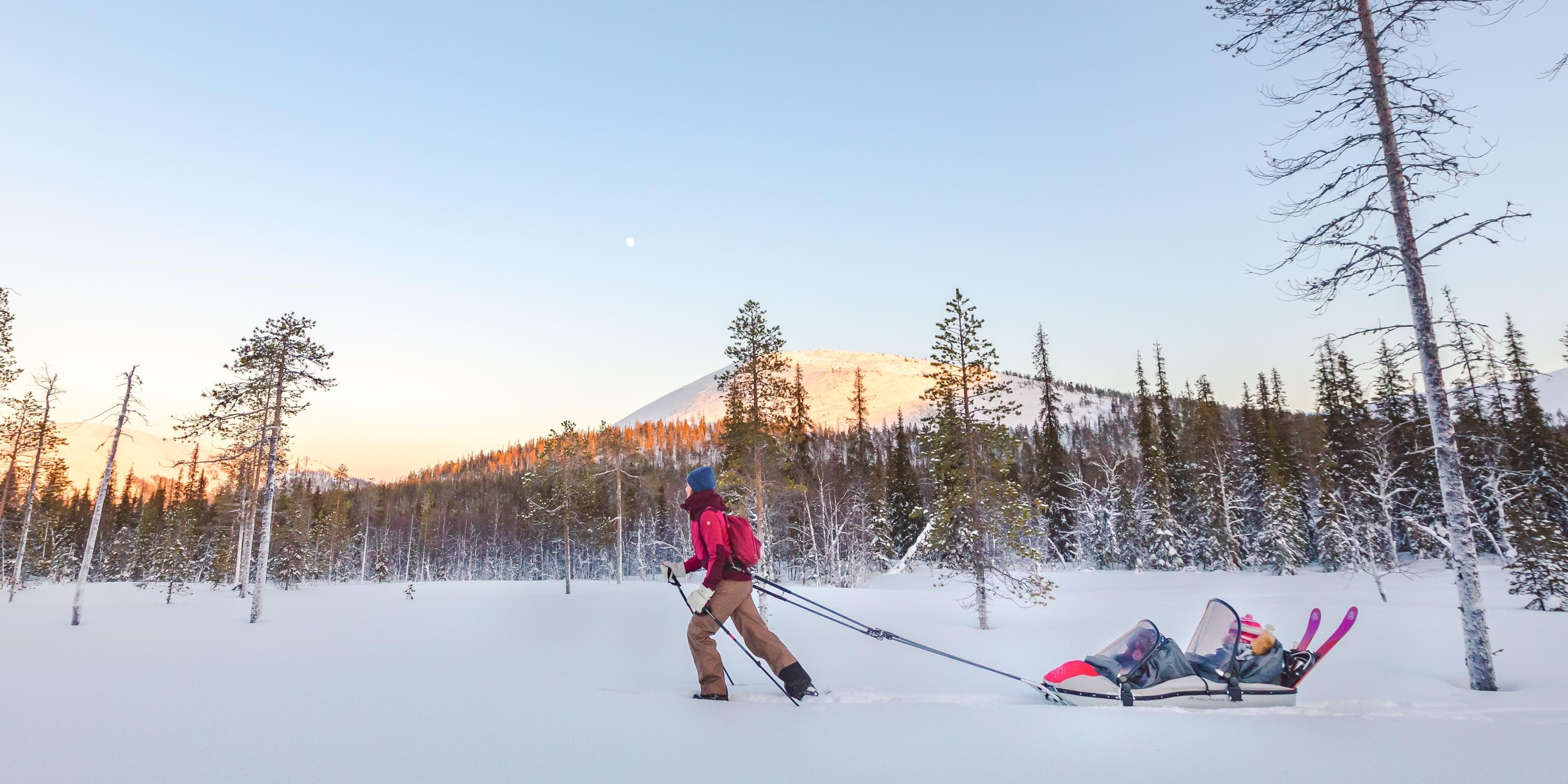
Don’t push too hard and take breaks
When you spend a long time outdoors in the winter, it is particularly important to avoid sweating. On a winter hike, it is a good idea to make adjustments to your clothing very actively, even though it may seem annoying to stop and take things off just when you just get going.
You should maintain a calm and easy pace - there is no need to rush. Breaks must be taken frequently enough, and it is advisable to grab small snacks and drink to maintain your performance. In order to maintain a steady pace, you should get as early a start as possible on your hike, so that you will not need to hurry when darkness begins to fall.
Also, avoid being too passive on winter hikes, as staying in one place for long periods increases the risk of getting cold. If, for one reason or another, you have to stay in one place for a longer period of time, put on your break clothes and move around a little bit to keep warm.
What is a good place to spend the night?
On your first overnight trips, you should choose a service structure, such as a wilderness hut or lean-to shelter, as your base. Even if you plan on sleeping out in a tent, the possibility of warming up in the hut or near a campfire provides a sense of safety.
Winter camping is also not for everyone, in which case a hut is a particularly good choice for staying overnight on a winter hike. On such hikes, you should consider booking a bed or rental hut, in which case overnight stays in the hut are guaranteed.
Even if you are heading to a hut, you must always pack some kind of shelter to deal with any emergencies you might encounter along the way. During the high season, wilderness huts and lean-to shelters may also be full of other guests.
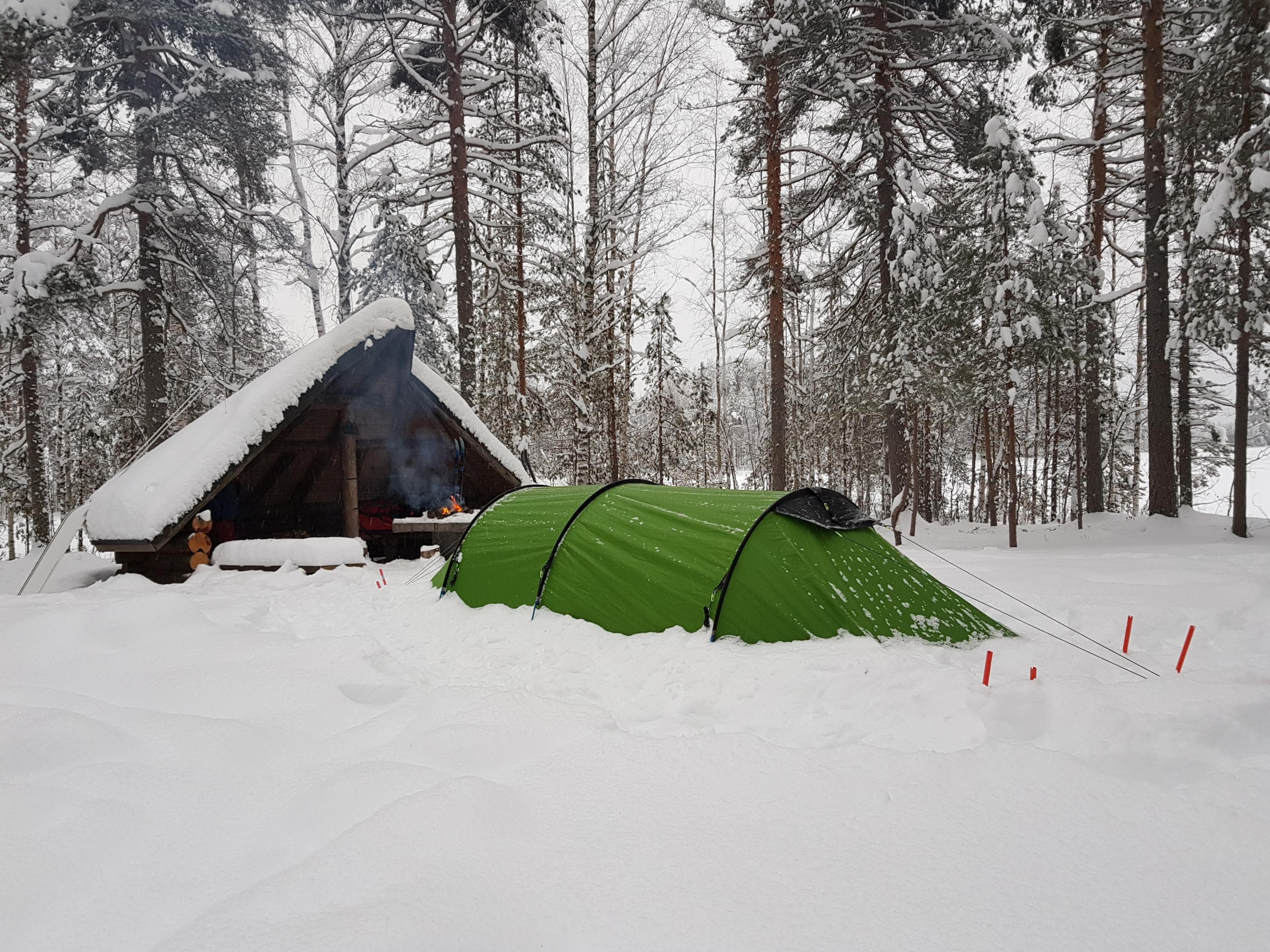
Short primer for winter camping
You should familiarise yourself with winter camping at least if you have a longer winter trek in mind. And even if you don’t, winter camping can be an amazing experience that not everyone gets to try.
What’s more, camping in a snowy environment is not as difficult as it first sounds. When you follow these tips, it is actually quite enjoyable.
You can survive a one-night trip in the forest in almost any tent, but a good 4-season tent is characterised by its separate indoor and outdoor tent, strong guy lines and snow flaps. However, even without these, you can do quite well. However, out on open fell terrain, tents must meet much higher performance requirements. This is discussed in an article on winter hike.
In Finland, with the exception of fells and larger water and mire areas, the snow is soft, so you must start setting up a tent by tamping down the snow on your campsite. The handiest way to do this is with your snowshoes or skis on. It is a good idea to tamp down an area larger than the tent, as this makes it easier to set your stakes. After tamping down the snow, allow it to harden.
Once the campsite has hardened and can be walked on, you can pitch the tent. Because a dome tent is freestanding, held up by its criss-crossing poles, it is easy to set up. A tunnel tent must be staked down. When using summer stakes in the winter, it is a good idea to carve out a small groove in the snow and place the stake there crosswise. It will hold better this way.
Snow stakes, which are longer than ordinary stakes and intended for setting up a tent in the snow, can also be used in winter hiking. You can buy these or make your own, for example, from plow markers or angle brackets.
If possible, it is a good idea to insulate the entire footprint of the tent using, for example, a foam frost mat or space blanket.
It is also important to ensure proper ventilation, as moisture is the worst enemy of a winter camper. It is therefore a good idea to leave the air vents open, provided that there is no snowstorm outside. You should also make every effort to keep as much as snow as possible out of the tent. For example, a small brush can help you remove any snow or frost from your clothes.
A good sleeping bag and pad ensure a warm night’s sleep
A sleeping bag and pad are essential to enjoying a winter hike. When choosing a sleeping bag, you should consider one designed to handle winter conditions, especially if you will be sleeping in a tent or lean-to shelter.
You can also make your sleeping bag warmer by combining a 3-season bag and a summer bag. This is done by inserting the thicker bag into the thinner one. When sleeping in this arrangement, condensation forms on the outer bag and the the inner bag stays warm and dry.
The sleeping bag should always be aired out in the morning so that the condensation can evaporate. The condensation turns into frost on the surface of the bag and can then be shaken or brushed off.
It is a good idea to use a pad with sufficient insulation as most of the heat inside the sleeping bag is lost from below.
When using an inflatable sleeping pad, your best choice is one filled with down or synthetic insulation. Air alone gets cold easily, but you can make an inflatable sleeping pad warmer by placing a foam sleeping pad on top of it to provide additional insulation. In any case, an inflatable sleeping pad is susceptible to punctures, so it is a good idea to always bring a foam sleeping pad along with you in the winter.
The foam mat footprint makes camping out overnight comfortable. These mats can be bought, for example, at your local hardware store by the metre. However, you will need a pulka to carry these.
Camp stoves in the winter
On an overnight night hike, you will need to cook several meals and sometimes also melt snow into water. This essentially makes the camp stove a necessity. However, a few things should be taken into account when using a camp stove in the winter.
Cold weather affects the fuel used in camp stoves. Especially when using a gas stove, the user should be aware that not all gases work in freezing temperatures. A specific winter or 4-season gas mixture must be purchased for winter use. There may be major differences in the quality of these fuels, and if the temperature drops to 20 degrees below the effective freezing point, the gas will no longer work at all. The effective freezing point refers to, for example, the coldness coefficient added by the wind, which must be taken into account when using a gas stove.
The performance of a methylated spirit stove may also deteriorate in freezing temperatures, as alcohol does not vaporise as effectively.
The surest choice for winter hikers is a multi-fuel stove that operates on gasoline, kerosene or light petroleum . Some models also use gas. If you want to use the same stove in the summer, this is the model to choose.
If you will be using a multi-fuel stoves on your hike, you will need to familiarise yourself with its operation and it will require some maintenance while out in the field. They are also more expensive than other stoves. If you already have a camp stove, there is no need to buy a multi-fuel stove until you start winter hiking on a regular basis.
If you want to use the stove in the snow, it is a good idea to bring some kind of platform for it. For example, a thin sheet of plywood works well. Melting snow to make drinking water goes faster if a sufficiently large pot is used on the winter hike. The pot lid saves fuel.
Cold makes it more difficult to manage your water supply, but provides opportunities for managing your food supply
In cold weather, managing your water supply becomes more difficult because everything freezes. If there is no liquid water near your campsite, you must melt snow to make water. This is a time-consuming process, so it is a good idea to set aside water, for example, in a few thermos bottles.
When melting snow for water, it is always a good idea to put in a small amount of “starter” water in the pot, as the bottom of the pot will scorch easily. After the snow has melted, it is a good idea to let the water boil for a while. You should make a larger amount of water in one go and store it in thermos bottles.
On the other hand, freezing temperatures actually make managing your food supply easier, as food is kept preserved by the cold. In other words, you can bring perishable or even frozen foods if the weather is cold enough. Various fresh foods can also be brought along, provided that they can withstand freezing.
If you are hiking with a pulka and your food has to stay thawed, you can pack it in a small cooler. The cooler can also be used to prevent water from freezing at the campsite.
